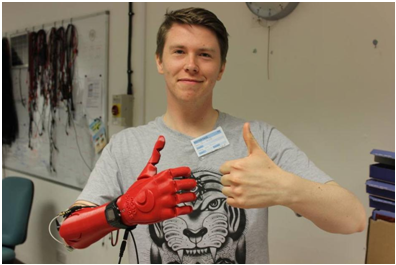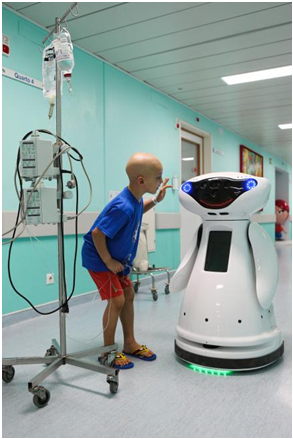ROBIOTICS- THE NEW PROMISED LAND OF CONVERGENCE – PART I
October 15, 2015

RoBIoTICS = A new land of convergence
Since the first industrial robot appeared in factories in the mid-twentieth century, robots have spread across to many domains – factories, the space, and more recently hospitals, homes or even your gardens!
Robots are a powerful factor of competitiveness, and their capabilities are evolving constantly, with new sensors, more processing power, or adaptation capabilities to their environment. A new generation of robots is emerging almost every year: playful or educational robots, robots for mobility assistance, body exploration, robotic prosthesis, robots embedded in cars, and so forth. Robots are in fact, becoming more anthropomorphic and potentially easier to accept for everyone.
However, there are still a lot of challenges ahead in many robotic domains such as personal robotics, automation/robotizing of transportation, medical robotics, robotics of exploration in hostile zones, robotics of services, miniaturization of robots, a formidable aspect being the societal challenges of robotics.more–>
The following animation shows the evolution of Robotics during the last 50 years, creating new markets and new businesses:
Robots are becoming pervasive in our lives, being entrusted to carry out tasks that humans usually perform. Robots are opening up new opportunities for entertainment and leisure activities, while being dependable and easy to interact with. Hospitals, factories and offices have conceptually similar requirements, but robots need to be adapted to their specific environments. Robots have been active in hospitals, factories and offices for years, performing a lot of miscellaneous tasks, such as the ‘MOnarCH MBOT’ operating at the IPOL Hospital in Lisbon (seen in this picture).
Two FP7 European-funded projects currently bring robots to our service:
- RoCKIn (“Robot Competitions Kick Innovation in Cognitive Systems and Robotics”) which organizes robot competitions that challenge researchers to develop robots to support humans in domestic and industrial tasks.
- MOnarCH (“Multi-Robot Cognitive Systems Operating in Hospitals”), which developed networked heterogeneous robots and sensors that interact with children, staff, and visitors, engaging in health-improving edutainment activities, in the pediatric infirmary of an oncologic hospital.
MOnarCH targets the development and demonstration of a team of mobile robots networked with other devices (i.e., a networked robot system, or NRS), such as video cameras, in the pediatric area of an oncological hospital, where they engage in health-improving edutainment activities with kids and staff.
The domain of Robotics is evolving fast. It is no more a closed ecosystem, and this evolution brings the convergence of new technical and business domains, new technologies, and very active R&D, adding new capabilities, new services and new use-cases to current robots.
A new “meta” domain is currently being born, that I call “RoBIoTics”, at the junction of many other innovative domains!
RoBIoTics is a new promised land of convergence for the next decades: Let’s discover why!
- Ro-Bio-TICS = “Biology” – convergence of Robotics and Biology domains
Robotics and Biology are pro-active fields of investigation, also often known as “BioRobotics”. But now, research in biology and robotics are converging faster to create hybrid entities:
- Robots assisted chirurgic allow less invasive interventions, and bring more precision in surgeons’ gestures thanks to new haptic interfaces.
- Robotic prosthesis and substitutes help disabled people replace their failed or cut organs:
- Exoskeletons help disabled people to walk better/again
- Miniaturized robotized endoscopic capsules to explore inside human body
- Robotic hand prosthesis allows amputees to use biomechanical hand(s) in place of their biological one(s)
- “Bionic” (robotic) eyes are becoming a reality and bionic vision is evolving rapidly. See how
- And some early-phase research made on electric spinal implants could lead to help paralyzed people walk again in the future
With the advents of 3D printing, new fields of research could also drive Robotics to become more “human friendly”:
- By creating robotic ears which look like real biological ears for example.

- By providing 3D printed robotic hand workshops to help design future prosthetics, such as OpenBionics
- By bringing together 3DPrinter owners with children who need hand prothesis such as the American association e-Nable
- Or by proposing robots everyone can build such as “Poppy” proposed by an open platform, with its 3D-printed body and its behavior programmed by the user
Outside of health/hospital domains, Robotics and Biology researches are also very proactive, e.g. by studying biological organisms to develop better robots, or building robots to better understand biological organisms:
- Bioengineers at Stanford created a robotic biology lab that can carry out remote-controlled experiments
- Biology-inspired robotics companies have created Robotics insects, such as Festo with its bionic Ants or its eMotion Butterflies that are able to demonstrate coordinated robotic flights
- Other companies are also actively involved in Bio-Robotics, with many different kind of biology-inspired robots or humanoids robots such as those from Boston Dynamics recently acquired by Google, or French Aldebaran Robotics with Nao or Pepper
The Biology-Robotics field is a very active domain for a long time now, and it has a promising and bright future, with incredible new innovations, revolutions, and interactions with humans or its environment. This convergence is going to accelerate in the years to come and a lot of innovations and surprises will soon be available for your everyday use.
But RoBIoTics is not only about Biology, other hot domains are currently converging and enriching Robotics with their own innovations. Let’s go deeper into it in my next blog posts.
(To be continued)… watch this space for the next blog post!

 English | EN
English | EN 
